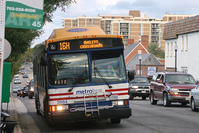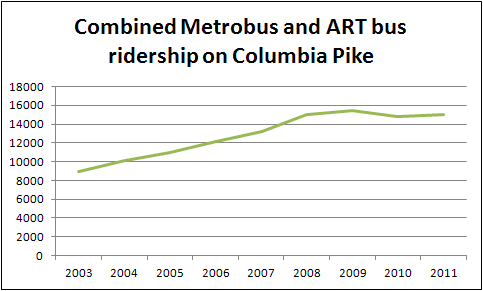Development aside, Columbia Pike needs streetcars

Photo by cliff1066 on Flickr.
The main argument for streetcars over articulated buses on Arlington’s Columbia Pike has been rail’s ability to focus redevelopment. While that is true, Arlington is also close to maxing out bus ridership in the Columbia Pike corridor. The only way to draw significantly more riders to transit will be to go beyond buses.
Even if a streetcar runs in traffic, it can carry more people than similarly situated buses. Many residents of Columbia Pike who don’t ride the bus have said in surveys that they would ride a streetcar.
Bus Rapid Transit might work if it ran in its own lane and didn’t have to mix with cars. Unfortunately, Columbia Pike is too narrow to fit a dedicated lane for buses. Short of going to the extreme expense of underground or elevated trains, transit along the pike is destined to operate in mixed traffic, whether on rail or wheels.
Buses have maxed out
Arlington is already capturing most of the riders along Columbia Pike who are willing to ride a bus in mixed traffic.
Combined ridership on the Metrobus and ART routes that serve Columbia Pike climbed rapidly for 5 years after 2003, when Arlington introduced when a set of service enhancements, dubbed “PikeRide.” However, since then ridership has stayed flat.
That lack of growth is partly a result of the economic downturn, but that isn’t the whole story. The highest ridership year overall was not before the recession but in 2009, at the recession’s nadir and when most transit agencies were experiencing steep declines. Meanwhile, ridership in 2010 and 2011, post-recession, remains down slightly from 2009.
WMATA fare increases may be partly to blame as well, but ART fares remain low, and ART ridership has not grown rapidly enough to offset the larger trend.
Market research indicates that the pot of residents willing to ride the bus has maxed out. 35% of Columbia Pike residents report riding the bus at least once per week. Of the 65% who report not riding, relatively few said they are willing to do so.
People say they will ride the streetcar
Contrast that with research on potential streetcar ridership. 59% of the same people surveyed say they would ride a streetcar along the same alignment at least once per week, compared to only 32% who said they would never ride. The last 9% are undecided.
Assuming that none of the undecided responders ride, the potential maximum ridership for streetcars on Columbia Pike is 68% more than the current maximum bus ridership. Thousands of people along the corridor who are not willing to ride the bus say they will ride a streetcar.
Streetcar opponents cite Arlington’s Alternatives Analysis (AA), which indicates a mere 5% bonus for rail ridership over bus, as evidence that the rail investment isn’t warranted. However, this 5% number was imposed by the Federal Transit Administration as a conservative estimate, and doesn’t reflect on-the-ground survey results. Thus, the AA dramatically underestimates likely streetcar ridership.
Streecars can move more people than buses
So far, all these numbers have been based on existing residents. If the anticipated streetcar-induced redevelopment does occur, that will bring in more transit riders. If the development happens without streetcars, the result could be more bus riders. However, in that scenario, Columbia Pike would face a major capacity problem.
Arlington is planning for about 16,000 new residents along Columbia Pike. If the same proportion of new residents ride transit as existing residents, that suggests that after redevelopment Arlington can expect about 5,600 new transit riders.
Buses on Columbia Pike are already running every 2-3 minutes. Running them more frequently would result in buses bunching together into groups so much that service wouldn’t actually improve, and might clog traffic more than it helps.
The next best way to substantially increase capacity is to run larger vehicles. While it’s true that articulated buses can carry more riders than regular buses, streetcars can carry even more. Depending on the internal configuration, a single streetcar can hold more than twice as many riders as an articulated bus. And streetcars can link into trains, increasing their maximum possible capacity further.
Carrying 5,600 new riders on top of the existing 15,000 using only articulated buses would be difficult, if not impossible. Meanwhile, thousands of other potential transit riders would still be opting not to ride because they just don’t like buses.
So, if additional development does not happen, Columbia Pike’s existing buses are already capturing most of the potential bus market in the corridor, and a streetcar is necessary to reach the thousands of residents who say they will ride trains but not buses. On the other hand, if additional development does happen, the additional capacity of streetcars over articulated buses will be necessary to accommodate all the new riders.
Either way, the streetcar is necessary.
You can comment on the Alternatives Analysis until Thursday, June 21. Let Arlington know that a streetcar is the right solution.

